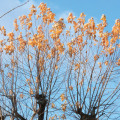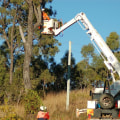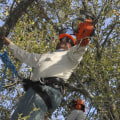Urban trees are often celebrated for their beauty and environmental benefits—providing shade, improving air quality, and enhancing the appeal of city streets. However, life in an urban environment presents serious challenges for trees that rural or forest-dwelling counterparts don’t face. Pavement, compacted soil, air pollution, and limited root space can all stress trees, compromising their health and longevity. In places like Miami Beach, where development and infrastructure dominate the landscape, maintaining urban trees requires specialized care and ongoing monitoring to ensure they thrive amid harsh conditions.
Pavement and Restricted Root Growth
One of the greatest challenges for city trees is the lack of adequate root space. Urban development often surrounds trees with concrete and asphalt, leaving little room for roots to expand or access oxygen and water. Roots trapped beneath sidewalks or streets can become deformed or shallow, leading to instability and nutrient deficiencies. This makes trees more susceptible to toppling during storms or high winds—a serious concern in coastal areas of Florida. To mitigate this, urban planners and arborists use techniques like permeable pavement systems and root barriers that allow water infiltration while protecting sidewalks from damage. Regular inspections are essential to monitor root health and prevent future structural issues that could endanger both people and property.
Pollution and Airborne Stressors
Air pollution poses another significant threat to urban trees. Vehicle emissions, industrial pollutants, and construction dust can clog leaf pores (stomata), reducing a tree’s ability to photosynthesize effectively. Over time, this can lead to premature leaf drop, stunted growth, or even tree death. Trees also absorb harmful gases such as ozone and sulfur dioxide, which can damage internal tissues. In highly populated cities, arborists often select pollution-tolerant species like live oaks, buttonwoods, and bald cypress to ensure better survival rates. Routine cleaning and pruning can help reduce the buildup of particulate matter, improving both the appearance and overall health of urban trees.
Soil Compaction and Water Management
Beneath the pavement, the soil surrounding urban trees often becomes compacted by foot and vehicle traffic, limiting oxygen flow and water absorption. This can cause roots to suffocate and lead to poor nutrient uptake. Inadequate drainage compounds the problem—heavy rains can pool around tree bases, while impermeable surfaces prevent natural infiltration. Implementing engineered soil systems and using mulch or permeable ground covers can help alleviate compaction and improve water distribution. Regular irrigation schedules and moisture monitoring are vital in preventing both drought stress and waterlogging.
Adapting Maintenance Practices
Urban tree maintenance differs significantly from care in natural environments. City trees require more frequent pruning, soil aeration, and pest monitoring to manage the stressors unique to urban living. Sometimes, despite best efforts, a tree’s condition deteriorates beyond recovery, posing safety risks to nearby structures and pedestrians. In such cases, professional services like tree removal in Miami Beach, FL become essential to safely manage hazardous trees while preserving the integrity of the surrounding landscape. Proper removal followed by replanting with resilient, native species ensures that urban green spaces continue to flourish sustainably.
Balancing Development with Sustainability
Maintaining healthy urban trees requires cooperation between city planners, arborists, and the community. Integrating green infrastructure—such as tree-lined streets, rain gardens, and rooftop vegetation—can reduce urban heat and support biodiversity. As cities expand, thoughtful design and proactive maintenance can create environments where trees not only survive but thrive. By addressing the impacts of pavement, pollution, and limited space, communities can safeguard the long-term health of their urban forests and the well-being of residents who depend on them.
Conclusion
Urban trees face constant stress from human-made environments, but with strategic maintenance, innovation, and public awareness, they can continue to enrich city life. Understanding the unique challenges posed by pavement and pollution allows communities to implement sustainable practices that protect both trees and people—ensuring that urban greenery remains a vital part of the landscape for generations to come.






